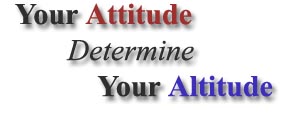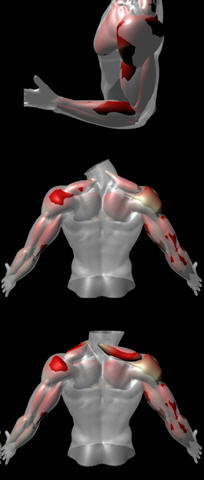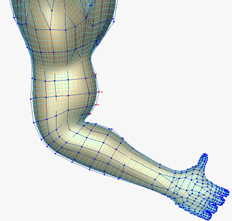Research Work

-
2003.3 - Now
National Centre for Computer Animation, The Media School, Bournemouth University, UK
Research Topic: Character Modelling and Animation, Physical based deformation
Project:
1. Arts and Humanities Research Council (AHRC) project: "Fast Animator Controlled Synthetic Creature Skin Deformations" (2003-2006)
2. Great Western Research (GWR) Project: Retargeting Animated Human Characters (2007.3 - )
Detail: My works are mainly focused on developing techniques and software tools for the modeling and animation of deformable characters. Currently I have worked out some algorithms on skeleton driven character deformation, Muscle modeling and deformation, subtle skin details like wrinkles and fat bulge, etc. Some content has been published. A few of maya plugins has been developed to include some of these functions.
Details:
1. Automatic muscle generation for character skin deformation [demo]
 As
skin shape depends on the underlying anatomical structure, the
anatomy-based techniques usually afford greater realism than the
traditional skeleton-driven approach. On the downside, however, it is
against the current animation workflow, as the animator has to model
many individual muscles before the final skin layer arrives, resulting
in an unintuitive and laborious modeling process. Here we worked out a
new anatomy-based technique that allows the animator to start from an
already modeled character. Muscles having visible influence on the skin
shape at the rest pose are extracted automatically by studying the
surface geometry of the skin. The extracted muscles are then used to
deform the skin in areas where there exist complex deformations. The
remaining skin areas are handled by the skeleton-driven technique,
allowing both techniques to play their strengths. It retains the
advantage of the realism of the anatomy-based skinning approach and at
the same time makes it both easy to use and compatible with the
animation workflow.
As
skin shape depends on the underlying anatomical structure, the
anatomy-based techniques usually afford greater realism than the
traditional skeleton-driven approach. On the downside, however, it is
against the current animation workflow, as the animator has to model
many individual muscles before the final skin layer arrives, resulting
in an unintuitive and laborious modeling process. Here we worked out a
new anatomy-based technique that allows the animator to start from an
already modeled character. Muscles having visible influence on the skin
shape at the rest pose are extracted automatically by studying the
surface geometry of the skin. The extracted muscles are then used to
deform the skin in areas where there exist complex deformations. The
remaining skin areas are handled by the skeleton-driven technique,
allowing both techniques to play their strengths. It retains the
advantage of the realism of the anatomy-based skinning approach and at
the same time makes it both easy to use and compatible with the
animation workflow.
The success of our AHRC project is mostly owing to the work on automatic muscle generation. It started in 2003. In 2006 acceptance by the journal of Computer Animation and Virtual Worlds validated the technical soundness of this idea. At the conference of Computer Animation and Social Agents and the following symposium "Human Character Modeling and Animation”, this work was very well received by both the research community and computer animation industry. Although the method presented here is still in the “theoretical stage”, its huge potential in the animation community has aroused lots of attentions and has been reported by New Scientist, Wiedza I Zycie and MIT Technic Review etc.
2. Bar-net driven skinning for character animation [demo]
 This
work aims to combine knowledge from both Physics and Art. By using a
mechanics model, we presents a physically feasible authoring tool for an
animator to design and produce realistic art pieces. It was published by
“Computer Animation and Virtual
World” and presented at the international conference
Computer Animation and Social Agents.
This
work aims to combine knowledge from both Physics and Art. By using a
mechanics model, we presents a physically feasible authoring tool for an
animator to design and produce realistic art pieces. It was published by
“Computer Animation and Virtual
World” and presented at the international conference
Computer Animation and Social Agents.
Character
deformation in computer animation has attracted a great deal of research
effort over the last two decades. The earlier models, despite being
cheap, had difficulties in creating realistic character deformations.
With the quest for realism, more physically based and CPU intensive
computation models have emerged, notably the multi-layered anatomy-based
approach. However, in addition to the computational cost, it is
undesirable to require the animator to model many muscles before the
skin shape is developed. In this paper, we propose a
physically-motivated deformation authoring technique, called bar-net
driven skinning. This technique is based on a physically inspired
deformation model from structural engineering, known as the
bar-networks (bar-net)
and can therefore deform realistically based on physical properties
leading to physically plausible outcomes. Meanwhile, instead of letting
the mechanical model take its full course, the animator is able to
operate it as a physically-based authoring tool in the same way as other
conventional deformation tools. Its main strength lies in the
combination of speed, intuitiveness and good realism. Our technique can
achieve similar results to those of the anatomy-based techniques, but in
an interactive manner.
3. Curve skeleton skinning for human and creature characters [demo]
 The
skeleton driven skinning technique is still the most popular method for
character animation. Albeit an industry de facto due to its
computational performance and intuitiveness, it suffers from a number of
problems such as collapsing elbow and candy wrapper joint. To remedy
these problems, one needs to formulate the non-linear relationship
between the skeleton and the skin shape of a character properly, this
however proves mathematically very challenging. In this paper, we
propose a method that is able to accommodate the inherent non-linear
relationships between the movement of the skeleton and the skin shape.
We use the curve skeletons
along with the joint based skeletons to animate the skin shape. Since
the deformation follows the tangent of the curve skeleton and due to
higher sampling rates received from the curve points, collapsing skin
and other undesirable skin deformation problems are avoided. The curve
skeleton still retains the advantages of the current skeleton driven
skinning. It is easy to use and allows full control over the animation
process. As a further enhancement, it is also fairly simple to build
realistic muscle and fat bulge effects.
The
skeleton driven skinning technique is still the most popular method for
character animation. Albeit an industry de facto due to its
computational performance and intuitiveness, it suffers from a number of
problems such as collapsing elbow and candy wrapper joint. To remedy
these problems, one needs to formulate the non-linear relationship
between the skeleton and the skin shape of a character properly, this
however proves mathematically very challenging. In this paper, we
propose a method that is able to accommodate the inherent non-linear
relationships between the movement of the skeleton and the skin shape.
We use the curve skeletons
along with the joint based skeletons to animate the skin shape. Since
the deformation follows the tangent of the curve skeleton and due to
higher sampling rates received from the curve points, collapsing skin
and other undesirable skin deformation problems are avoided. The curve
skeleton still retains the advantages of the current skeleton driven
skinning. It is easy to use and allows full control over the animation
process. As a further enhancement, it is also fairly simple to build
realistic muscle and fat bulge effects.
Other Demos:
1. Simulate the muscle deformation (RMVB)
2. Dancing Character (Avi)
3. Deformation on the upper arm (rmvb)
4. Wrinkle simulation (rmvb)

- 2001.6 - 2002.6 The
Virtual Reality, Visualization and Imaging Research Center, CUHK
2000.6 - 2003.3 Visualization and Computer Graphics Lab, Tsinghua University, P.R.China
Research Topic: Virtual Endoscopy, Visualization of Scientific Computing, Tetrahedral Mesh Generation
Project: Augmented Reality System for Endoscopic Surgery Simulation and Operation
Detail: Leading a R&D group include three doctor students and 3 master students. The research topics include medical image processing, modeling of human organs, finite element analysis for soft tissue, realistic rendering, virtual reality system integration. My specific R&D work is focused on the reconstruction of surface and volume model of human organs from medical images.
From June 2001 to June 2002, I worked in the The Virtual Reality, Visualization and Imaging Research Center of CUHK as a RA to continue the work on the project. The R&D group was moved from Tsinghua University to Hong Kong and was extended by several doctor students in CUHK. In this period, our work was mainly focused on the algorithm development and programming, system integration, 3D knee modeling from VHP anatomical images, the design of the force feedback device etc. We got a prototype system at the end of this period of work and got very good response from medical officers for the system. The final system can be found at Virtual Arthroscopy System.
Demos:
- Knee Arthroscopy Surgery Simulation (rmvb)
- Presentation (ppt)

-
1996.3-2000.6 National Key Laboratory of Structural Analysis of Industrial Equipment, Dalian University of Technology, P.R.China
Research Topic: Scientific Visualization, CAD, distributed computing
Project:
(1) 3D geologic modeling techniques for rimose oil field with latent fault, cooperated with Liaohe Oil Field in the Northeast of China.
(2) CAD/CAE software - JIFEX. Responsible for the development of X-WINDOW version (Platform: SGI Indigo Entry4000). Function focuses on Finite element analyze post-processing - Contour plotting, structure slice, animation, volume rendering, iso-surface generating and user interface.
(3) Design and implementation of some optimization algorithms using a distributed computing model on 5 SGI machine group, cooperated with Dept. of Mathematics
-
1994.11-1996.1 CAD & CG National Key Lab, Zhejiang University, P.R.China
Research Topic: Intelligent Computer Graphics
Project: Knowledge based painting program - RIS95 developed on X-WINDOW on Sun Workstation, Function focus on Real-time Shading method combined with basic knowledge of painters, knowledge database management.